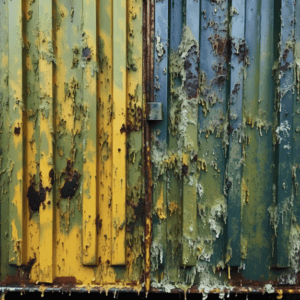Shipping containers are commonly used for storage, whether it’s for personal belongings or business inventory. However, if not properly maintained, these containers can become a breeding ground for mold. Mold can cause damage to your items and pose a health risk.
In this article, we’ll go over how to prevent mold in shipping containers. Read on to learn how.
The Importance of Preventing Mold in Storage Units
Mold growth can be a serious issue in storage containers, as it can damage your stored items and pose health risks. Mold thrives in environments with moisture buildup, which is often the case in closed and poorly ventilated storage units. When mold starts to grow, it can spread quickly and contaminate other items, making it difficult to salvage your belongings.
Preventing mold in shipping containers involves taking proactive measures to control moisture levels. This can be done by using dehumidifiers, ensuring proper ventilation, and regularly inspecting container walls for signs of mold growth.

Choose Your Boxes Wisely
You can prevent mold growth in your shipping containers by choosing your boxes wisely and using materials that are resistant to moisture. When selecting boxes for storage, opt for ones that are made from materials that don’t absorb moisture, such as plastic or metal. These materials are less likely to retain water and promote mold growth.
Additionally, consider using moisture-resistant packaging materials inside the boxes to further prevent moisture build-up. For example, you can use desiccant packets or moisture-absorbing packets to absorb any excess moisture inside the storage container.
The Advantages of Using Breathable, Acid-Free Boxes for Specific Items Like Art or Books
For specific items like art or books, there are several advantages to using breathable, acid-free boxes.
When it comes to preserving delicate items like art or books, it’s crucial to provide them with the right environment. Breathable boxes allow air to circulate, preventing the buildup of moisture that can lead to mold or mildew. These boxes are designed to keep the items dry and protected, ensuring their longevity.
Additionally, using acid-free boxes is essential for preserving the quality of these specific items. Acidic materials can cause irreversible damage to art prints or book pages over time. By using acid-free boxes, you can prevent yellowing, discoloration, and deterioration, ensuring that your precious art or books remain in pristine condition for years to come.
Clean and Dry Items Before Storing
Make sure to clean and dry all of your items before storing them to prevent mold growth in your shipping container. Moisture is a key factor in mold growing, so it’s crucial to eliminate any dampness or residual moisture from your belongings.
Start by thoroughly cleaning your items to remove any dirt, dust, or debris that may contribute to mold growth. Use a gentle cleaning solution and a soft cloth to wipe down surfaces, ensuring that all areas are clean and dry. Pay special attention to fabrics, as they can easily retain moisture.
Before storing clothes, make sure they’re completely dry, either by air-drying them or using a dryer.
Additionally, consider using moisture-absorbing products such as silica gel packets or desiccant bags inside your shipping container to further prevent mold.
Potential Risks of Storing Damp Items, Such As Mold Growth and Damage to Metals or Woodwork
Ensure that proper precautions are taken to prevent the potential risks of storing damp items, such as the growth of mold and the potential damage to metals or woodwork.
Mold can quickly develop in shipping containers if items are stored while still damp, leading to potential health hazards and costly damage. Mold thrives in moist environments, and the high humidity inside shipping containers provides the perfect breeding ground mold spores. Once mold starts to grow, it can spread rapidly, contaminating other stored items and causing unpleasant odors.
Additionally, dampness can cause metal to rust and woodwork to warp or rot, compromising the structural integrity of the container. To avoid these risks, it’s crucial to thoroughly dry and inspect items before storing them in shipping containers, ensuring that they’re free from moisture and potential mold growth.
Regular inspections and maintenance should also be conducted to promptly address any signs of damage or mold growth.
Pack Desiccators in Your Containers
To prevent moisture buildup and inhibit mold growth, be sure to pack desiccators in your containers and use them in conjunction with other preventive measures.
Desiccators, such as silica gel, are highly an effective method at absorbing moisture and maintaining a dry environment. When packing your shipping containers, place sealed containers of silica gel strategically throughout the space. These desiccators will actively absorb any excess moisture in the air, reducing the risk of mold growth.
Remember to check and replace the silica gel regularly to ensure its effectiveness.
Tips on Checking Expiration Dates and Replacing Them As Needed
To ensure the effectiveness of your desiccators in preventing mold growth, regularly check their expiration dates and replace them as needed. Checking the expiration dates is crucial because these desiccators rely on their moisture-absorbing properties to keep your shipping containers mold-free. Over time, the desiccators may lose their effectiveness and become less efficient at absorbing moisture.
By checking the expiration dates, you can identify when it’s time to replace them with new ones. It’s recommended to have a schedule for checking the expiration dates of your desiccators, ensuring that they’re always up to date.
Additionally, when replacing the desiccators, make sure to follow the manufacturer’s instructions for proper installation and usage. By being diligent in checking expiration dates and replacing as needed, you can maintain the effectiveness of your desiccators in preventing mold growth in shipping containers.

Think Airflow
To prevent mold in your shipping containers, ensure proper airflow throughout the container. Adequate airflow is crucial in preventing moisture buildup, which can lead to the growth of mold. Proper ventilation is key to achieving this. Consider installing vents or louvers in the container’s walls to remove moisture and allow air to circulate freely.
Additionally, insulation plays a vital role in maintaining the ideal temperature and humidity levels inside the container. Insulating the roof and walls can help prevent condensation and reduce the risk of mold growth.
By prioritizing airflow and ventilation, you can create an environment that discourages mold growth and keeps air inside your shipping containers mold-free.
Don’t underestimate the importance of these measures in maintaining the integrity of your goods and ensuring a safe and healthy shipping experience.
Recommendations on How To Arrange Boxes and Items To Promote Proper Ventilation
Ensure that you have enough space between boxes and items, but also keep them organized and grouped together in order to promote proper ventilation.
When arranging boxes and items in shipping containers, it’s essential to create a layout that allows air to circulate freely. Start by leaving a gap of at least a few inches between each box. This space will allow air to flow between the boxes, preventing the accumulation of moisture and reducing the risk of mold growth.
Additionally, try to arrange the items in a way that promotes airflow. Place larger and bulkier items at the back or on the sides of the container, leaving the front and center areas open for air movement.
Opt for a Climate-Controlled Unit
Are you wondering if you should choose a climate-controlled unit?
When it comes to preventing mold in shipping containers, opting for a climate-controlled unit is a wise decision. These units provide a controlled environment with temperature and humidity settings that help prevent the growth of mold and mildew.
By maintaining a stable climate, a climate-controlled storage unit can effectively prevent moisture buildup and condensation, which are the primary causes of mold growth. With the ability to regulate the temperature and humidity levels, you can ensure that your items stored in shipping containers remain safe and mold-free.
How These Units Maintain Optimal Ventilation and Prevent Excessive Moisture
To ensure optimal ventilation and prevent excessive moisture, climate-controlled storage units use high-quality ventilation systems and effective dehumidifiers.
These units are designed to prevent mold in shipping containers by controlling the indoor humidity levels. Moisture can accumulate inside containers due to warm moist air coming into contact with cooler surfaces, leading to condensation and the formation of mold.
Climate-controlled units combat this issue by removing excess moisture from the air and preventing condensation through dehumidifiers. These dehumidifiers work by drawing in the air, cooling it, and collecting the resulting condensation.
Additionally, climate-controlled units are equipped with high-quality ventilation systems that allow for proper airflow. Grate style vents are often used to promote air circulation, preventing the buildup of stagnant air and reducing the chances of container rain.
Frequently Asked Question
How do you keep mold out of a storage container?
To prevent mold in storage containers, it’s essential to control the humidity within the storage area. Proper ventilation is crucial, and items should be stored off the ground. Before placing anything inside, ensure that all items are thoroughly dry.
How do you get rid of mold in a shipping container?
To eliminate mold from a shipping container, start by cleaning and disinfecting the container, preferably with vinegar. Incorporate desiccants like silica to absorb excess moisture.
Can mold grow in a shipping container?
Yes, mold can indeed grow in shipping containers. Factors such as contamination of products, the presence of wet items, damp packing materials, and variations in air content can contribute to mold growth. Damp air within the container can also be a significant factor.
What can I put in a container to absorb moisture?
There are several materials you can use to absorb moisture in containers. Silica Gel is a powerful desiccant made from sodium silicate that effectively attracts moisture. Clay absorbers offer a more affordable alternative, though they might not be as efficient. Calcium Chloride is another potent moisture absorbent commonly used in shipping goods.
Conclusion
In conclusion, preventing mold in shipping containers is crucial to protect your stored items.
By choosing the right type of boxes and considering climate-controlled storage for certain items, you can greatly reduce the risk of mold damage.
Remember to take proactive measures to ensure the safety and longevity of your belongings.


